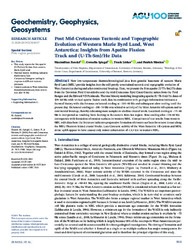Post Mid-Cretaceous Tectonic and Topographic Evolution of Western Marie Byrd Land, WestAntarctica: Insights from Apatite FissionTrack and (U-Th-Sm)/He Data
DOI: https://doi.org/10.1029/2019GC008667
Persistent URL: http://resolver.sub.uni-goettingen.de/purl?gldocs-11858/8939
Persistent URL: http://resolver.sub.uni-goettingen.de/purl?gldocs-11858/8939
Zundel, Maximilian; Spiegel, Cornelia; Lisker, Frank; Monien, Patrick, 2019: Post Mid-Cretaceous Tectonic and Topographic Evolution of Western Marie Byrd Land, WestAntarctica: Insights from Apatite FissionTrack and (U-Th-Sm)/He Data. In: Geochemistry, Geophysics, Geosystems, Band 20, 12: 5831 - 5848, DOI: 10.1029/2019GC008667.
 |
Dokument öffnen: |
New low-temperature thermochronological data from granitic basement of western Marie Byrd Land (MBL) provide insights into the still poorly constrained tectonic and topographic evolution of West Antarctica during and after continental breakup. Here, we present the first apatite (U-Th-Sm)/He data from the Devonian Ford Granodiorite and the mid-Cretaceous Byrd Coast Granite suites from the Ford Ranges and the Edward VII Peninsula. Thermal history modeling integrating apatite (U-Th-Sm)/He dates of 109–68 Ma with revised apatite fission track data in combination with geologic information indicates a thermal history with diachronous enhanced cooling at ~100–60 Ma and subsequent slow cooling until the present day. Enhanced cooling at ~100–70 Ma was related to activity of the West Antarctic rift system and to continental breakup, thereby exhuming most samples to shallow crustal levels. Localized cooling at ~75–60 Ma is interpreted as resulting from faulting in the eastern Ross Sea region. Slow cooling after ~70–60 Ma corresponds with formation of erosion surfaces in western MBL. Comparison of our results from western MBL with data from the literature indicates progressive formation of erosion surfaces from west to east along the MBL-Thurston Island crustal blocks. Late Cenozoic activity of the West Antarctic rift system and MBL dome uplift appear to have caused only minor exhumation of <1.5 km in western MBL.
Statistik:
ZugriffsstatistikSammlung:
This is an open access article under the terms of the Creative Commons Attribution License, which permits use, distribution and reproduction in any medium, provided the original work is properly cited.

